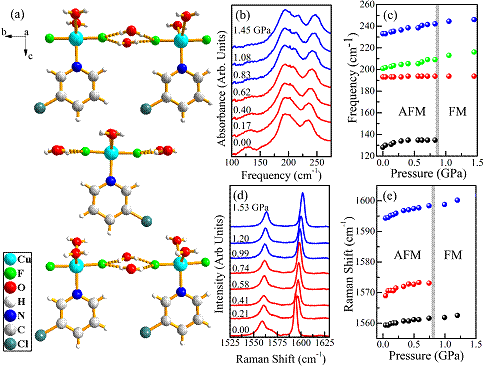58th Annual Report on Research 2013 Under Sponsorship of the ACS Petroleum Research Fund
Reports: ND1052053-ND10: High Pressure Properties of Materials
Janice Lynn Musfeldt, University of Tennessee
Program scope
The goal of our research program is to establish a fundamental understanding of the mechanisms underlying the interplay between charge, structure, and magnetism in complex materials. This insight will facilitate the development of tunable multifunctional solids and nanomaterials, which are scientifically and technologically important. Our main strategy involves investigating the dynamic response of functional materials under external stimuli such as high magnetic fields, under unusual chemical and photochemical activation, and at very small sizes where quantum confinement becomes apparent. This allows us to learn about the relationships between different ordered and emergent states, explore the dynamic aspects of coupling, and gain insight into the generality of these phenomena and their underlying mechanisms. In addition to broadening the understanding of novel solids under extreme conditions, multifunctional materials and their assemblies are of interest for light harvesting, spintronic, and solid state lubrication applications.
Recent progress
This ACS-PRF New Directions initiative extends our program on “materials under extreme conditions” to include pressure as a complementary tuning parameterthus allowing us to examine coupling phenomena that were previously out of reach. Two examples in which pressure triggers a magnetic crossover in quantum magnets are detailed below. We are also working to integrate high pressure synchrotron-based spectroscopy into our regularly funded NSF program on molecule-based materials, and we acquired our own diamond anvil cell to set up high pressure capabilities in our home laboratory rather than relying solely on the facilities at the synchrotron.
Pressure-induced local lattice distortions in α-Co[N(CN)2]2: The interplay between structure and magnetism underpins a variety of properties in functional materials. Spin-lattice interactions stabilize the development of many interesting ground states, for instance spin Peierls, multiferroic, and the fully polarized state that results from a magnetic quantum critical transition. Magnetostructural correlations are traditionally developed using a combination of bulk magnetic and structural probes like susceptibility and x-ray diffraction, magnetostriction measurements, and vibrational spectroscopies. α-Co[N(CN)2]2 ([N(CN)2]- = dicyanamide) attracted our attention as a system where the bulk aspects of magnetoelastic coupling have received sustained attention but where the microscopic signatures of this coupling are wholly unexplored. We find that the α → γ structural transition at 1 GPa takes place with a crystallographic change that doubles the number of Co2+ centers in the cell and reduces the symmetry. Local structure modifications include CoN6 counter-rotation, distortion and elongation of the octahedra, and flattening of the C-Nax-C linkages. The 3 GPa phase transition involves more modest lattice and local structure changes. These distortions alter the super-exchange interactions and drive the pressure-induced ferromagnetic → antiferromagnetic crossover. Our analysis of mode Gruniessen parameters reveals that this system is unlikely to display negative thermal expansion. Finally, we show that there is not a simple low pressure pathway between the pink α and blue β ambient pressure phases of Co[N(CN)2]2.
Figure 1: (a) Close up views of the room temperature Raman spectrum of α-Co[N(CN)2]2 at ambient pressure and 5 GPa. (b) Frequency vs. pressure plots of this data. Gray vertical lines denote critical pressures, and the three phases are labeled as α, γ, and d. (c) Schematic diagram of the CoN6 counter-rotation mode.
Pressure-induced hydrogen bonding changes drive magnetic crossover in pentacoordinate CuF2(H2O)2(3-Clpyr): This quantum magnet attracted our attention due to its unusual trigonal bipyrimidal copper environment, extensive two dimensional hydrogen bonding network, and a pressure-induced magnetic transition at 0.8 GPa that drives the system from an antiferromagnetic to ferromagnetic state. We combined diamond anvil cell techniques, synchrotron-based vibrational spectroscopies, and complementary lattice dynamics calculations to investigate the mechanism of the pressure-induced transition in CuF2(H2O)2(3-Chloropyd). Our work reveals that the magnetic crossover takes place with significant lattice involvement. In particular, ring tilting brings the chlorine center closer to the H2O ligands, and Cl…H interactions open up the bond angle. This process establishes additional hydrogen bonding linkages in the c direction that can act as superexchange pathways between copper centers. Development of this new exchange pathway combined with the buckled ab plane hydrogen bonding interactions yields a three dimensional superexchange network between copper centers that facilitates the antiferromagnetic to ferromagnetic crossover and stabilize the three-dimensional long-range ordered state.
Figure 2: (a) Crystal structure of CuF2(H2O)2(3Cl-pyd) showing hydrogen bonding along the b direction. (b, c) Infrared spectra as a function of pressure between 0 and 1.5 GPa. (d, e) Selected mode frequencies vs. pressure through the 0.8 GPa magnetoelastic transition. The vertical gray line indicates the antiferromagnetic → ferromagnetic crossover. The infrared and Raman spectra reveal the local lattice distortions that trigger this crossover.
Copyright © 2014 American Chemical Society













